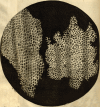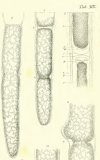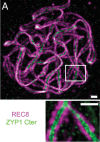A Short History of Plant Light Microscopy
- PMID: 36200878
- PMCID: PMC11648834
- DOI: 10.1002/cpz1.577
A Short History of Plant Light Microscopy
Abstract
When the microscope was first introduced to scientists in the 17th century, it started a revolution. Suddenly, a whole new world, invisible to the naked eye, was opened to curious explorers. In response to this realization, Nehemiah Grew, an English plant anatomist and physiologist and one of the early microscopists, noted in 1682 "that Nothing hereof remains further to be known, is a Thought not well Calculated". Since Grew made his observations, the microscope has undergone numerous variations, developing from early compound microscopes-hollow metal tubes with a lens on each end-to the modern, sophisticated, out-of-the-box super-resolution microscopes available to researchers today. In this Overview article, I describe these developments and discuss how each new and improved variant of the microscope led to major breakthroughs in the life sciences, with a focus on the plant field. These advances start with Grew's simple and-at the time-surprising realization that plant cells are as complex as animals cells, and that the different parts of the plant body indeed qualify to be called "organs", then move on to the development of the groundbreaking "cell theory" in the mid-19th century and the description of eu- and heterochromatin in the early 20th century, and finish with the precise localization of individual proteins in intact, living cells that we can perform today. Indeed, Grew was right; with ever-increasing resolution, there really does not seem to be an end to what can be explored with a microscope. © 2022 The Authors. Current Protocols published by Wiley Periodicals LLC.
Keywords: GFP; cell biology; confocal microscope; light microscopy; microscopy; plant biology; science history.
© 2022 The Authors. Current Protocols published by Wiley Periodicals LLC.
Conflict of interest statement
The author declares no conflict of interest.
Figures










Similar articles
-
Using a replica of Leeuwenhoek's microscope to teach the history of science and to motivate students to discover the vision and the contributions of the first microscopists.CBE Life Sci Educ. 2009 Winter;8(4):338-43. doi: 10.1187/cbe.08-12-0070. CBE Life Sci Educ. 2009. PMID: 19952102 Free PMC article.
-
Functional comparative histology. 5. Communication: History of histology.Gegenbaurs Morphol Jahrb. 1985;131(6):815-62. Gegenbaurs Morphol Jahrb. 1985. PMID: 3910505
-
From Animaculum to single molecules: 300 years of the light microscope.Open Biol. 2015 Apr;5(4):150019. doi: 10.1098/rsob.150019. Open Biol. 2015. PMID: 25924631 Free PMC article. Review.
-
A brief history of how microscopic studies led to the elucidation of the 3D architecture and macromolecular organization of higher plant thylakoids.Photosynth Res. 2020 Sep;145(3):237-258. doi: 10.1007/s11120-020-00782-3. Epub 2020 Oct 5. Photosynth Res. 2020. PMID: 33017036 Free PMC article. Review.
-
The history of the microscope reflects advances in science and medicine.Semin Diagn Pathol. 2025 Mar;42(2):150831. doi: 10.1053/j.semdp.2024.01.002. Epub 2024 Jan 11. Semin Diagn Pathol. 2025. PMID: 38627186 Review.
Cited by
-
Methodology to enable high-throughput imaging of Arabidopsis seedlings on cover glass-bottom multiwell plates.MicroPubl Biol. 2024 Sep 25;2024:10.17912/micropub.biology.001255. doi: 10.17912/micropub.biology.001255. eCollection 2024. MicroPubl Biol. 2024. PMID: 39391294 Free PMC article.
-
Regulation of epithelial cell jamming transition by cytoskeleton and cell-cell interactions.Biophys Rev (Melville). 2024 Oct 14;5(4):041301. doi: 10.1063/5.0220088. eCollection 2024 Dec. Biophys Rev (Melville). 2024. PMID: 39416285 Review.
-
Imaging the living plant cell: From probes to quantification.Plant Cell. 2022 Jan 20;34(1):247-272. doi: 10.1093/plcell/koab237. Plant Cell. 2022. PMID: 34586412 Free PMC article. Review.
References
-
- Abbe, E. (1873). Beiträge zur theorie des mikroskops und der mikroskopischen wahrnehmung. Archiv Für Mikroskopische Anatomie, 9(1), 413–418.
-
- Abbe, E. (1874). Neue apparate zur bestimmung des brechungs‐ und zerstreuungs‐vermögens fester und flüssiger körper. In Neue Apparate zur Bestimmung des Brechungs‐ und Zerstreuungs‐vermögens fester und flüssiger Körper. Mauke's Verlag. Retrieved from https://hdl.handle.net/2027/uc1.$b24494
-
- Abbe, E. (1881). On the estimation of aperture in the microscope. Journal of the Royal Microscopical Society, 1(3), 388–423. doi: 10.1111/j.1365-2818.1881.tb05909.x - DOI
-
- Abbe, E. (1906). Erster Band. Abhandlungen über die theorie des mikroskops. In Gesammelte Abhandlungen. Verlag von Gustav Fischer. Retrieved from https://archive.org/details/gesammelteabhan02abbgoog
Publication types
MeSH terms
Substances
LinkOut - more resources
Full Text Sources

